Blue skies— smiling at me! Nothing but blue skies do I see! And ain’t it the truth, folks. Here Scottfield Theatre Company is trying to open their holiday production of Irving Berlin’s White Christmas and what does Havre de Grace, Maryland give ‘em? 71 ° weather with brilliant, bright blue skies! It’s like Pine Tree, Vermont, complete with no snow! Directed by Chuck Hamrick with Musical Direction by Nathan Scavilla and Choreography by Becky Titelman, even the unseasonably warm weather can’t keep Scottfield Theatre Company from spreading a healthy heap of holiday cheer with this iconic Christmas movie-musical turned stage show.
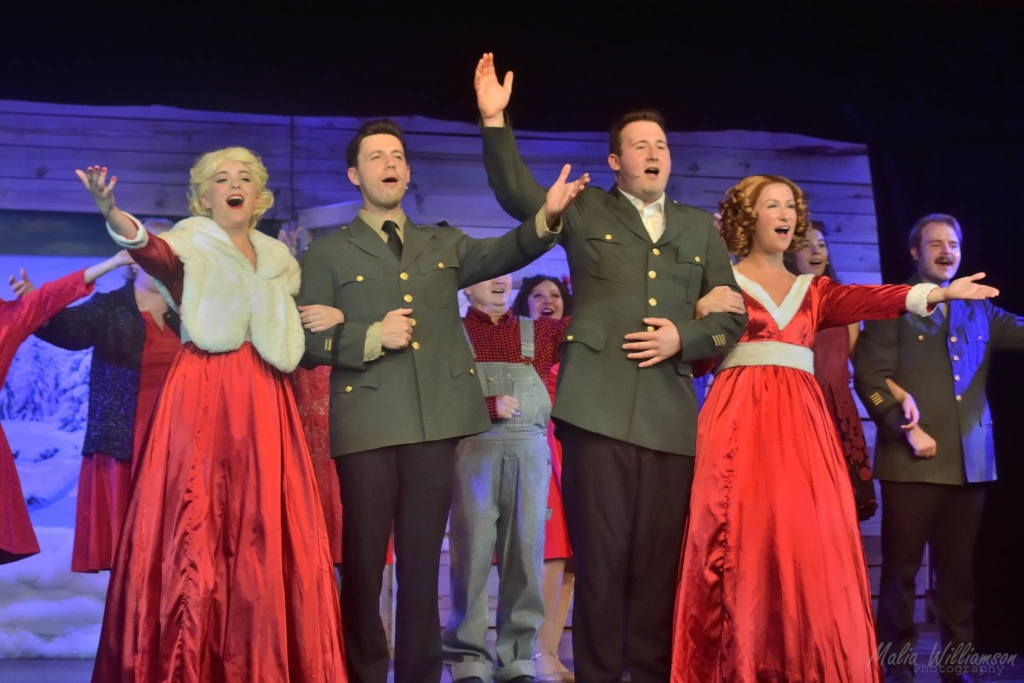
At first, the scenery appears simple; Set Designer Benjamin Marsh works the curtains of the backdrop into playing nicely with a lot of the popping, moving colored lights (hailing from Lighting Designer Patrick Yarrington.) But when everybody finally arrives in Pine Tree, Vermont— The Columbia Inn to be specific— Marsh’s real talents shine through. The wooden paneling, warm and beaming with rustic charm, create the perfect allusion of ‘the barn’ and the gorgeous scenic painting revealed behind the barn doors near the show’s end takes you straight into a Thomas Kinkaid Christmas painting (compliments to set painter Keri Freberger.)
The show’s costumers— Beverly Whaley & Elizabeth Marion— round out the overall production aesthetic, giving everyone that mid-50’s aesthetic. Everything from the performance dresses to the garters holding up the fellas’ socks fit the bill. If there’s one complaint to be made in Whaley & Marion’s otherwise wonderful work it’s the jeans on General Hank Waverly in the first act. While jeans were making themselves popular in that era, they seem out of place for the General character, especially as he spends most of the second act in black slacks. And normally such a minor detail wouldn’t be so irksome, it’s just that the production is so close to perfect you don’t want anything pulling focus from the talented performers and overall astonishing feat of the production. The dresses for the women- particularly the fashionable ones featured on the Martha Watson character— the snazzy military uniforms, it all fits together so wonderfully; Whaley & Marion do a nearly perfect job of giving White Christmas that polished, Hollywood 1950’s aesthetic.
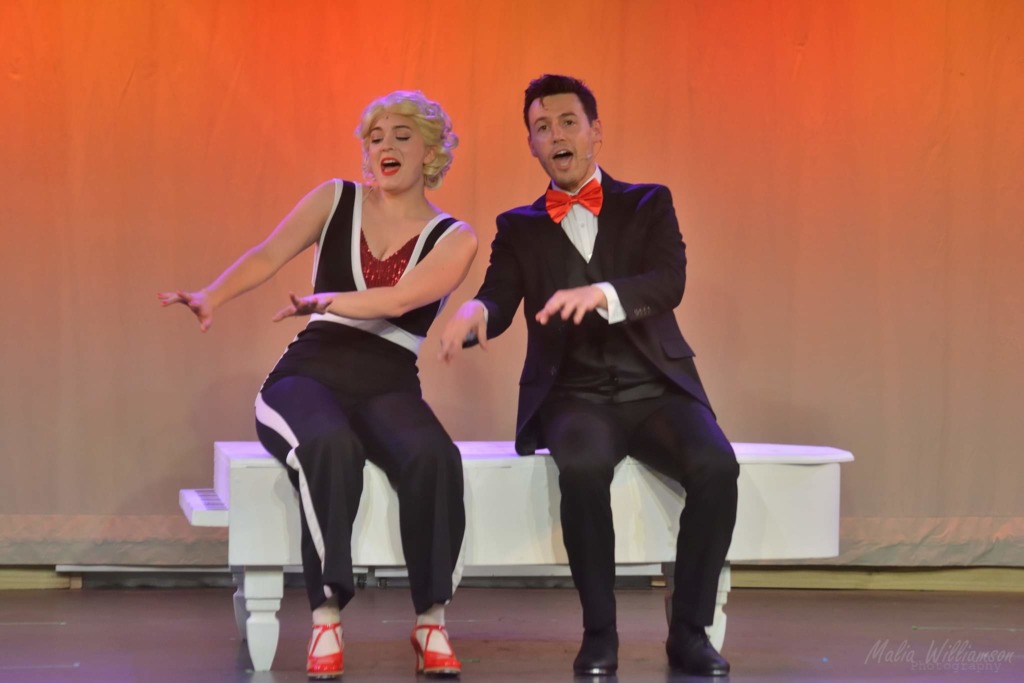
You’ll be dazzled and amazed by the sheer intensity and professionalism that comes to fruition in the form of the show’s choreography, crafted and fabricated into existence by Choreographer Becky Titelman. There’s no denying that Titelman has a talented ensemble (with two exceptional leads in the Phil Davies and Judy Haynes roles adding their skilled and seasoned dancing experience into the mix.) Titelman focuses intensely on the tap-dancing in this production, and rightly so as it is a staple feature of the movie and of every production of Irving Berlin’s White Christmas. “Blue Skies” and “I Love a Piano” feature the aforementioned sensational routines. Titelman’s choreography has you feeling as if you’ve been whisked straight into the middle of the fantasy world of dancing movie-musicals from yesteryore. It’s lively, energetically invested, cleanly executed, and perfectly timed to the music.
Speaking of music, even with the tinned tracks, Musical Director Nathan Scavilla has the performers delivering those robust, classic sounds of the times, really engaging each of the show’s musical numbers in a most enchanting fashion. You get the warm welcoming sounds of the holidays from this cast under the skilled direction of Nathan Scavilla and it’s just the perfect aural landscape to titillate the ears and get your mind in the Christmas spirit. Director Chuck Hamrick runs a tight ship; the play progresses smoothly with well-practiced scenic transitions. The stage doesn’t appear crowded, the blocking for the show is overly spaced. If there’s a minor complaint— and this begs the age-old question of onus in community theatre when it comes to casting— it’s that Hamrick’s choice for Bob Wallace feels just a little out of place when paired against the other three featured leads. It’s not that he isn’t a good performer, he is, but rather that he looks younger, sounds younger, and sounds and moves with more modernity than the actors playing Betty & Judy Haynes and Phil Davis. Betty, Judy, and Phil feel like they’re soundly fixed in 1954 while the Bob Wallace actor has a much more modern read. But this is a minor point of contention for what is otherwise a sensational show, and as mentioned, is sometimes the nature of community theatre (casting comes from those that show up to auditions.)
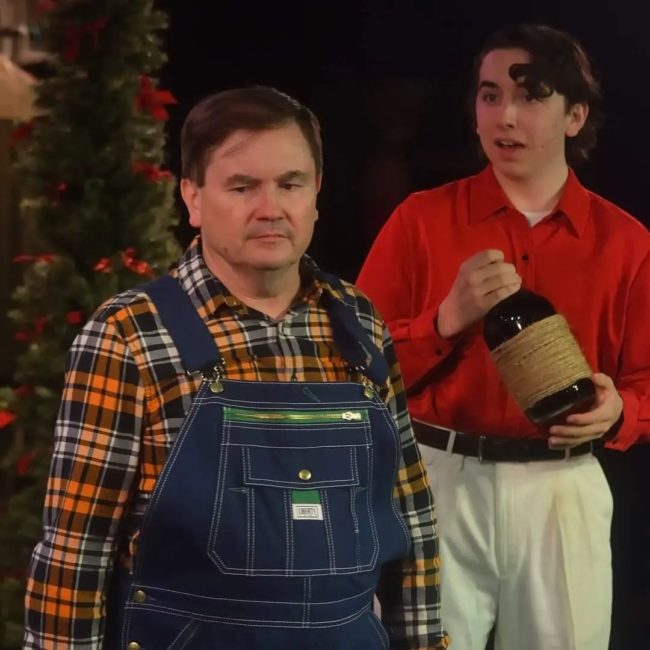
The hardworking ensemble (Chris Barsam, Jay Connelly, Carly Greaver, Marlanea Guidotti, Gabby Harris, Michelle Hosier, Samantha Jednorski, Laura May, Jams Meadows, Pamela Provins, Sam Ranocchia, Tracey Zimmerman) are lively and eager to share their Christmas spirit with the audience. Jednorski and Guidotti, who double up as the Roto-Router-Twin-Terrors Rita & Rhoda, are just to plucky and punchy for words. Their shrieking-teases of poor ‘Phil-ly Dilly’ are just hilarious and they add a nice comic salt to the bunch. Add into the mix of strong performances from the ensemble that of Albert Boeren as Ezekiel and Tate Menges as Mike and you’ve got a real scream. While Menges’ stage-managing Mike is a bit more subdued than some of the over-the-top notions that often lend itself to the character, he delivers a solid sense of urgency when bemoaning the fact that the stage manager’s office is a literal pig-stye, complete with pig! Boeren, as the monosyllabic Ezekiel just steals the scenes. With his patented slow-shuffle and his singular nod and “Ayup” (which runs together to just sound like a one-syllable word) Boeren has the audience tittering away in stitches, especially when he finds his one moment in the spotlight just after “I Love a Piano.” And don’t forget Haydn Floros as Shelldrake. While not the comic-crackups that Ezekiel, Rita, and Rhoda are, Floros holds his own when it comes to that ‘million dollar proposition.’
Bursting out with surprising pipes and a clear sense of showmanship, Siena Bauer takes the role of little Susan Waverly and just knocks it clean out of the park. With vocal capabilities that appear to far-surpass her physical years, when she takes to her version of “I’m Happy”— hold onto your hats, fellas, because her vocal capacity and sheer prowess will knock them right off your heads. You can tell Bauer is channeling a little bit of General Waverly into the Susan character— makes sense as Susan is the General’s granddaughter— but she has her softer moments too, like when listening to Bob Wallace sing “Count Your Blessings Instead of Sheep.” As the brusque, cantankerous, barking General Waverly, Adam Biemiller brings a tenderness to the role, particularly when he carries little Susan off to bed after that ‘Blessings’ number. You get that same, humane tenderness again when Biemiller addresses the ‘company’ near the end of the production and it’s a nice contrast to the otherwise gruff and prickly nature he presents all throughout the show up to those two points.
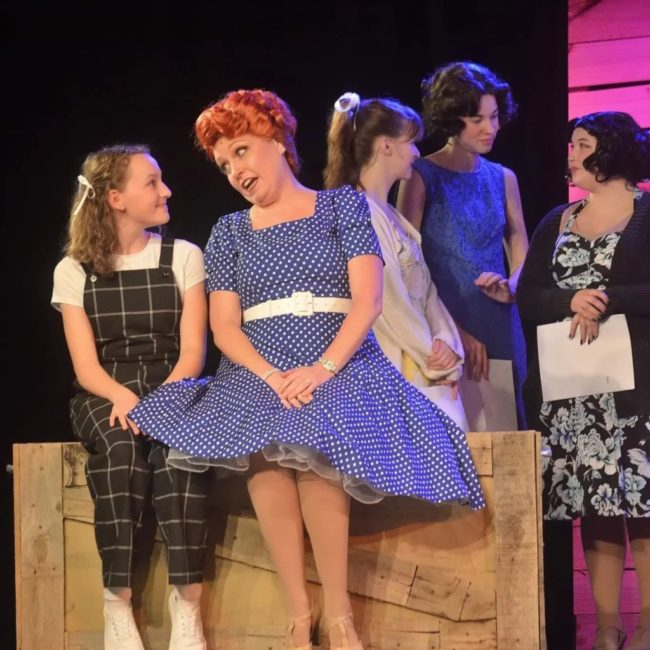
Channeling her best Lucille Ball aesthetic with a whole lot of gumption and a keen understanding of a young-bordering-on-middle-aged-character woman, Elizabeth Marion just runs away with her scenes as Martha Watson (not to be confused with Martha Washington— she’s not that old!) Marion is a proper hoot and just delivers all the best 1950’s realness in this caricature-character of Martha. She’s got some of the most impressive dresses in the show and she moves with the ease of a woman from the 1950’s, graceful and yet with purpose. And when she sings— the astonishing belt that flies out of her mouth for “Let Me Sing and I’m Happy” will really bowl you over; it’s got that iconic low-mezzo range that is just sublime. Marion understands the humors, has vivacious facial expressions and is an all-round perfect fit for the role in this performance.
It’s a four-way split at the top of the leading roles pyramid— is it Bob Wallace (Adam Kurek) and Phil Davis (Mickey Orange) or Betty (Emily Rice) & Judy (Maggie Dennis) Haynes? Or Bob & Betty and Phil & Judy? Anyway you slice it you’ve got four really great vocalists and two stellar dancers (it’s the Phil & Judy tracks who get all the fancy footwork!) Adam Kurek, despite modernity and youth, has a solid voice, which gives good clear tones when singing numbers like “Blue Skies” and “Count Your Blessings Instead of Sheep.” Kurek does have a natural smile that just warms your heart when the Bob character deigns to smile with it.
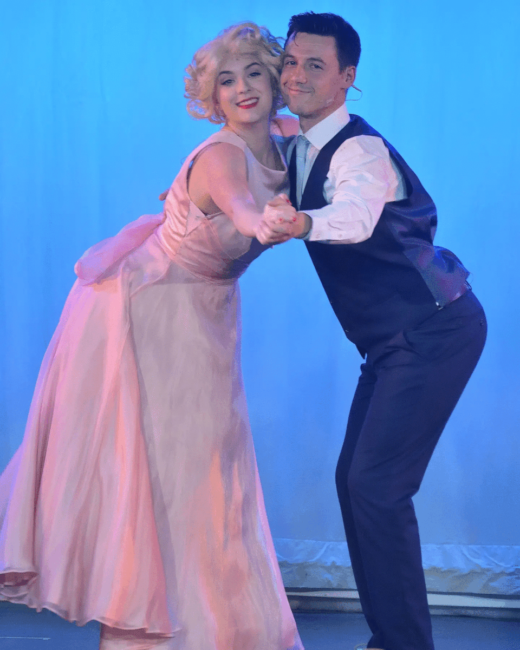
Moody and frosty but compassionate in her own right, Emily Rice finds a way to make Betty Haynes versatile. It’s easy to fall into the trap of just making her cold and uncaring right up until that moment where the script says she has to be. Rice’s interactions with Bob Wallace are prickly and agitated, though her initial comedic nervousness is quite clever. When she’s singing and dancing, sharing the stage with her sister Judy, Rice’s Betty looks most at home. You can see this readily during “Sisters” though she gets a chance to show-off this fun-loving sing-song nature during “Falling Out of Love Can Be Fun” as well— the number is a trio featuring Rice, and the Betty & Martha characters. There is a sensual lounge nature that possesses Rice’s voice for “Love, You Didn’t Do Right By Me”, the solo bit that her character gets to deliver at the Regency Room (in a stunning midnight velvet dress no less) and Rice speaks with an easy understanding of the cadence of the time.
Judy Haynes (Maggie Dennis) is just a perfect pip! With the darkened eyebrows, pale-made-up face, and wildly expressive eyes against her Marilyn-Monroe-blonde wig, she is the epitome of a 1950’s gal. Delovely voice that just wafts through her music numbers, Dennis is such a delight in the role of Judy. She dances with grace and ease, making the exhausting routines— both “The Best Things Happen While You’re Dancing” and “I Love a Piano”— look effortless and easy-peasy. It’s astonishing to watch her twirl, float, tap, and twist all over that stage, up on the piano, and all around the Phil Davis character without ever missing a step, a beat, or even breaking a sweat. Her patois and overall delivery when speaking is almost a replica any ‘sister-act’ of the times and she is just a gem and an overall delight to observe, particularly as her chemistry and connection with Phil Davis blossoms and blooms throughout the production.

Mickey Orange could be Danny Kaye, if Danny Kaye was a time-traveler who had made it all the way to 2022. Simply the best, most lively, most authentic, most charming, most wonderous Phil Davis I think I have personally ever seen (and that’s saying something as I’ve covered close to a dozen productions of White Christmas in as many years), Mickey Orange is the character. Even when he’s having little asides about rolling up trouser legs for his rendition of “Sisters” with Bob Wallace, you feel like he’s existing and thriving in 1954. His understanding of comedic timing is flawless and his facial expressions are the perfect balance of the side-kick comedy man the 50’s generation came to expect from performers such as him. Orange’s balanced charisma and charming airs read as authentic and extremely enjoyable and his voice is extraordinary, particularly when drifting through “I Love a Piano.” A true knockout sensation as Phil Davis, Mickey Orange is an iconic holiday classic, a true White Christmas staple, and will have your heart swooning with joy every time he sets foot onto the stage.
So if you too are dreaming of not 71 °+ weather, if you’re hoping for something a little more traditional when it comes to Christmas weather, then you must see Scottfield Theatre’s White Christmas this holiday season.
Running Time: 2 hours and 35 minutes with one intermission
White Christmas plays through November 2oth 2022 with Scottfield Theatre Company in the Cultural Center at The Havre de Grace Opera House— 121 N. Union Street in historic downtown Havre de Grace, MD. For tickets call the box office at 667-225-8433 or purchase them online.

